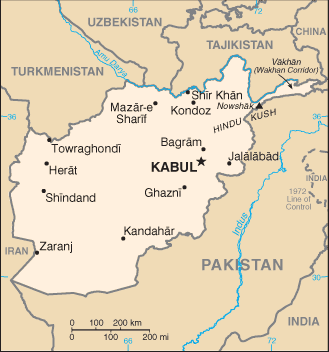Vetting Afghans
One of the concerns about the Afghan Adjustment Act (AAA) by some
critics is the vetting issue. According to some government reports, news
media reports, and critics some of the Afghan refugees did
not undergo a thorough vetting process before being resettled in U.S.
communities across the country.
The cited
government reports
state there were a small minority of
the Afghan evacuees that arrived in
the United States that had derogatory information in their files.
Critics are citing these reports as a basis for not supporting
the Afghan Adjustment Act.
Supporters of the Afghan Adjustment Act argue that a security and
vetting provision within the proposed legislation provides for a robust
screening and vetting process prior to the 'adjustment of status'
and the pursuit of lawful permanent resident status (Green Card). This
is in addition to the numerous screening and vetting processes during
the months-long road from Kabul airport to the resettlement in
communities around the United States.
National Vetting Center (NVC). National Security
Presidential Memoradum-9 (NSPM-9) established the
National Vetting Center with the Department of Homeland Security
(DHS) as the lead agency on 6 February 2018. Operational partners
include the DOJ, DOS, DOD, FBI, CIA, NSA, NCTC, ODNI, and others. The
NVC is a whole-of-government interagency fusion center designed to
centralize and standardize U.S. government security screening for
individuals seeking to enter the or remain in the U.S.
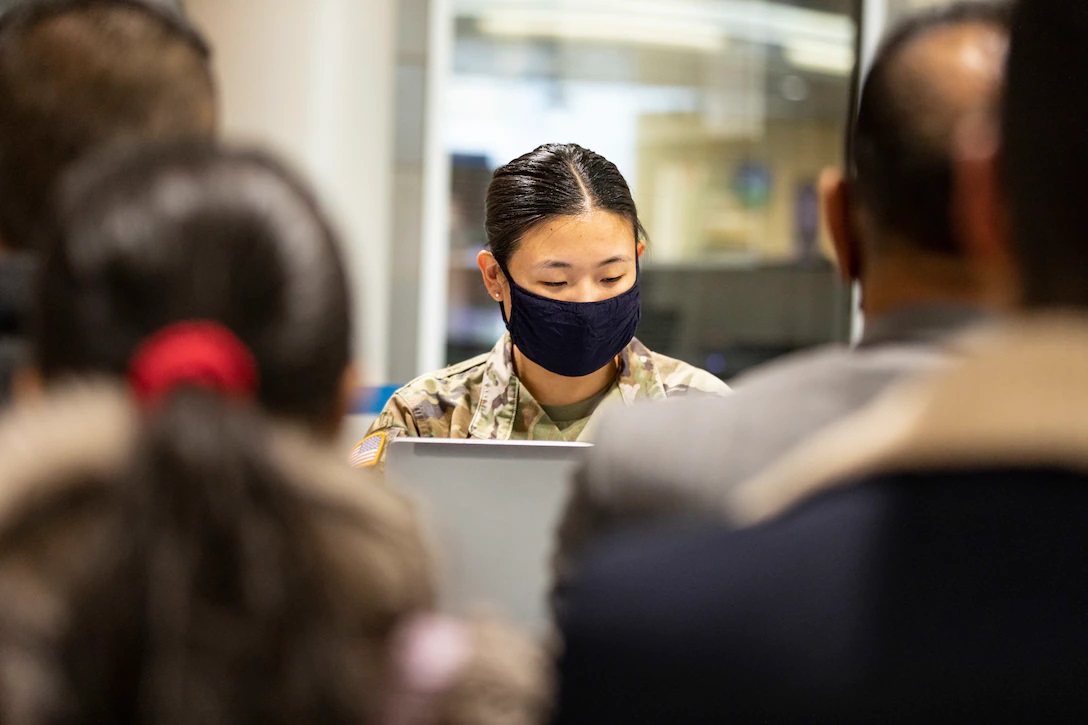
Army Specialist Grace Ryoo checks in Afghan guests as they arrive at the
Philadelphia International Airport (photo US Army, Nov 24, 2021)
Afghan Adjustment Act Provides
for a Thorough Vetting Process
The AAA provides for a thorough and robust vetting process for Afghans
who are already resettled in the United States. As part of the process
to 'adjust their status' outlined by the AAA the Afghans will undergo a
very rigorous vetting process - equivalent to the United States Refugee
Admissions Program (USRAP).
When Afghans apply to 'adjust their status' either as an SIV, asylee, or
under the Afghan Adjustment Act, the Department of Homeland Security runs additional security and medical
checks, completes a comprehensive biometrics analysis (again), and
conducts interviews before approving an applicant to make sure
individuals are not national security or public safety threats to the
United States. This additional layer of screenings is critical to ensure
those who apply to adjust status remain in good standing in the United
States.
Under the Afghan Adjustment Act additional screening and vetting is conducted before an individual receives
permanent status to reside in the U.S. If an individual does
not pass the screening process - would not be able to adjust thier
immigration status. As a result, that individual
may be deemed ineligible for legal permanent residency in the United
States and they may be placed in removal proceedings.
The vetting process is the
same as the screening and vetting process for refugees from outside the United States
and who wish to come to the United States. This process is defined in
Refugee Security Screening Fact Sheet, United States Citizen and
Immigration Services (USCIS), June 3, PDF, 7 pages.
https://www.uscis.gov/sites/default/files/document/fact-sheets/Refugee_Screening_and_Vetting_Fact_Sheet.pdf
The refugee vetting process is fully explained in this report by the
International Refugee Assistance Project (IRAP). Read Debunking
"Extreme Vetting": Recommendations to Build Back the U.S. Refugee
Admissions Program, IRAP, June 2021, PDF, 49 pages.
https://refugeerights.org/wp-content/uploads/2021/06/Vetting-Report-2020-v6-REVISED-JUNE-2021-1.pdf
How Afghan Evacuees Were Vetted
Before Release to U.S. Communities
From August 2021 to mid-summer 2022, intelligence, law enforcement, and counterterrorism professionals
were
conducting a robust, multi-layered screening and security vetting
process for all Afghans before they arrived in the United States and
again once they arrived in America on one of the eight military
installations or at the National Conference Center in Virginia.
This comprehensive investigation includes reviews of both biographic and
biometric data checked against U.S. and international intelligence databases.
The U.S. analyzes names, dates of birth, fingerprints, and other
comprehensive biographic identifiers against multiple domestic and
international agencies' holdings, including the terrorist watchlist.
Afghans arriving with humanitarian parole also receive pre-and
post-arrival medical screenings and vaccinations. Additionally, the
Department of Homeland Security (DHS), the Department of Defense, the
Federal Bureau of Investigation, the National Counterterrorism Center
(NCTC), and additional Intelligence Community (IC) partners conduct
multiple security screenings and security vetting procedures.
The steps of the screening and vetting process during the Kabul NEO
(August 2021) and after the NEO (September 2021 to present) are outlined
below.
Screening Process During the Kabul NEO
August 15-31, 2021
Afghan evacuees who gained entry to the Hamid Karzai International
Airport (HKIA) subsequently boarded U.S. military planes for secondary
destinations throughout the region where they underwent screenings, interviews, and biometric checks
before
they journeyed to the United States. The screening at HKIA was rapid due to the huge number of evacuees and the chaotic situation.
Screenings continued at secondary locations known as 'lily pads', U.S. military installations in the Middle
East and Europe, and were much more thorough. In addition, Afghan evacuees
went through 'port of entry' checks by the Customs and Border Protection
(CBP) upon arrival at a U.S. airport. After arrival in the United States
the Afghan evacuees were transported to one of eight U.S. military
installations located around the country and underwent
additional screening. The
evacuees were on these military installations for several
weeks to several months before resettling in communities across the
United States. Many of the Afghans evacuated during August 2021 were
former interpreters or members of the Afghan military. Interpreters for
the U.S. military went through a robust screening process before
employment, with repeated counterintelligence interviews for the
duration of their contracts. Members of the Afghan military, after 2011, also had a
screening process as well before
recruitment.
The graphic below
describes the vetting process that went into effect after in the months
after the fall of Afghanistan to the Taliban and the end of the
non-combatant evacuation operation (NEO) on August 31, 2021. The graphic
can be found on the
Infographics page of the Afghan Evac website.
Screening at the 'Lily Pads' and Ports of Entry
August 15, 2021 to Present
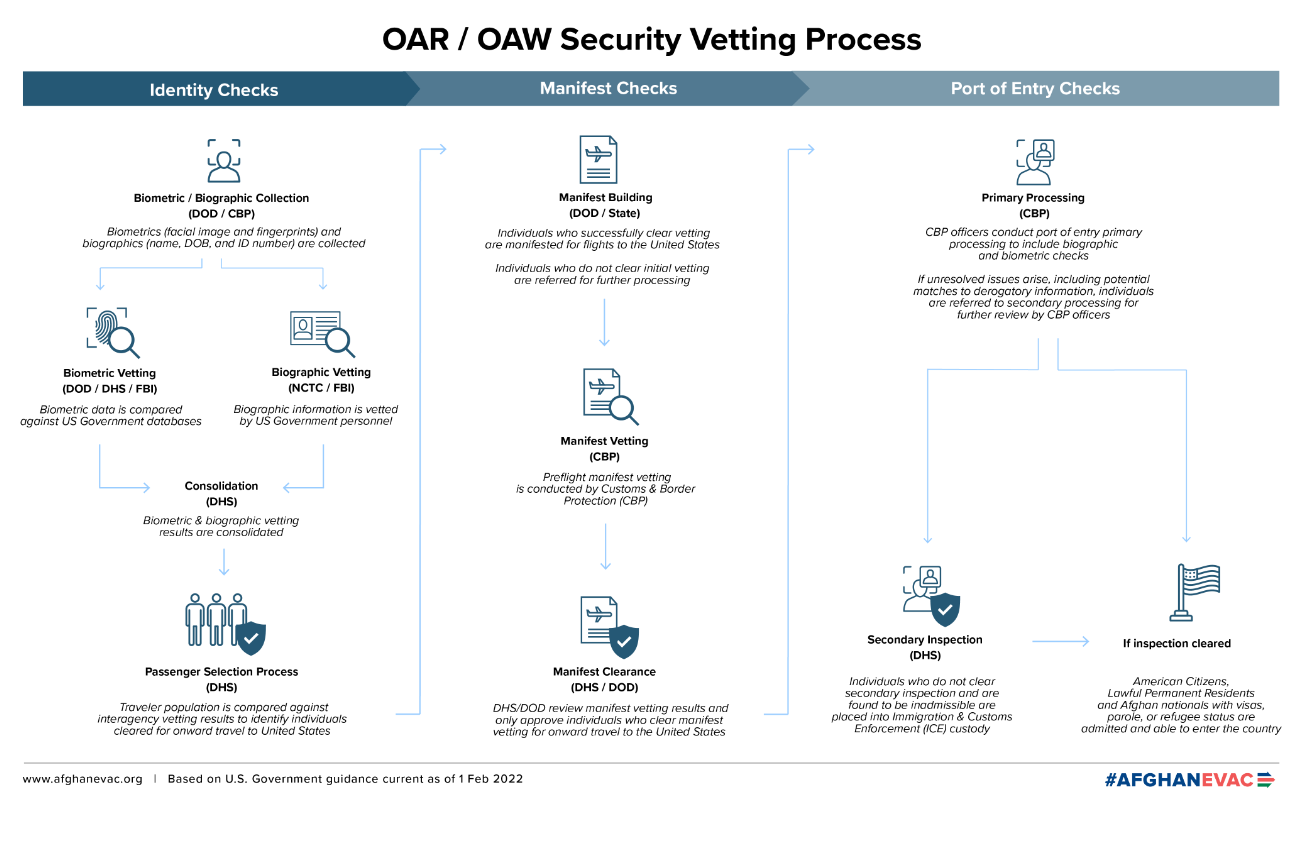
Afghan Evac, February 2022
(click
here for larger image)
Screening at Kabul Airport during NEO - Aug 2021
During the chaotic Kabul non-combatant evacuation operation at Kabul
airport in August 2021 the screening and vetting process was sometimes
rushed and incomplete. More thorough follow-on processes would occur
once the Kabul flight reached the Middle East transit locations or 'lily
pads'. From there, many Afghans were flown to U.S. military
installations in Europe to ease the crowded conditions on U.S. military
bases in the Middle East.
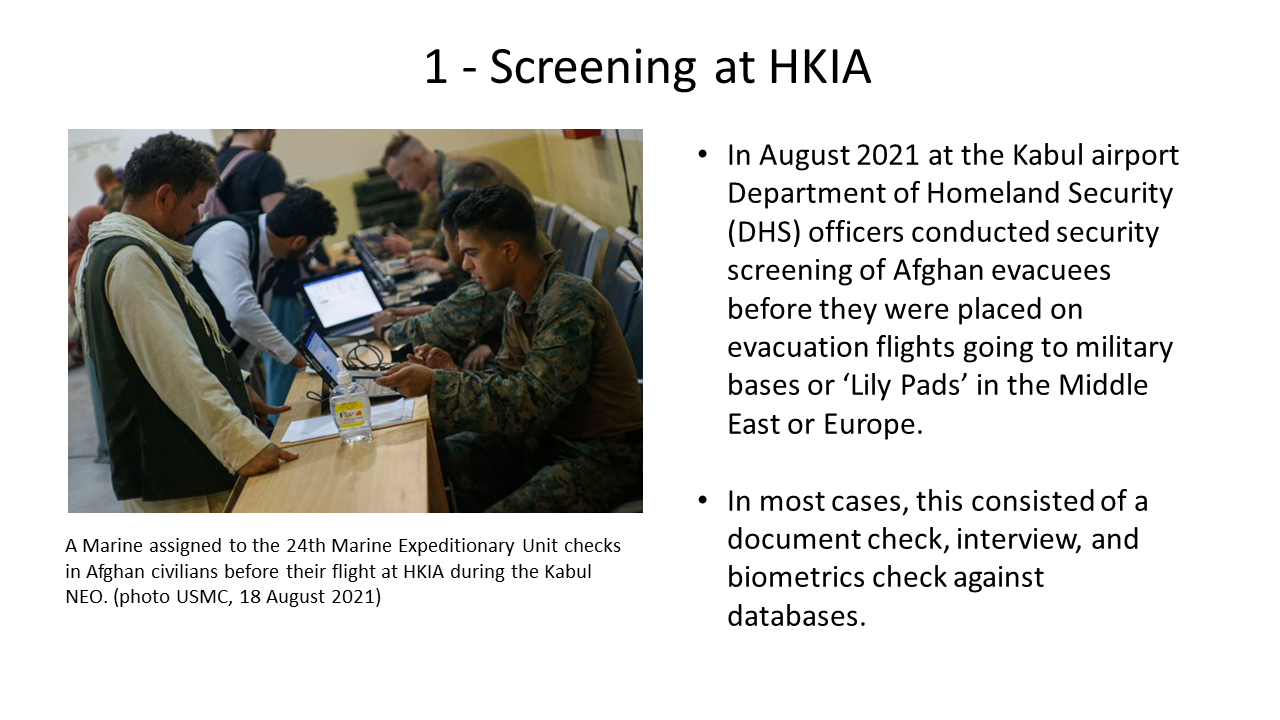
(click
here for a larger image)
Screening at 'Lily Pads' - Overseas Transit Locations
The U.S. government conducted health checks, administration processing,
and security screening of Afghans
while they were housed on a temporary basis on U.S. military
installations (lily pads) in Europe and the Middle East. While at the
lily pads Afghan evacuees had their information input into the DoD
Automated Biometric Identification System (ABIS) as well as the DHS
Automated Biometric Identification System (IDENT). Multiple steps
were taken to ensure that those seeking entry do not pose a national
security or public safety risk. Read
more here on the
vetting and screening process conducted on the 'lily pads'. (click
the + sign next to "Operational Phases"). Those Afghans found
with derogatory information or whose situation required additional
interviews and vetting were tranferred to
Camp Bondsteel, Kosovo.
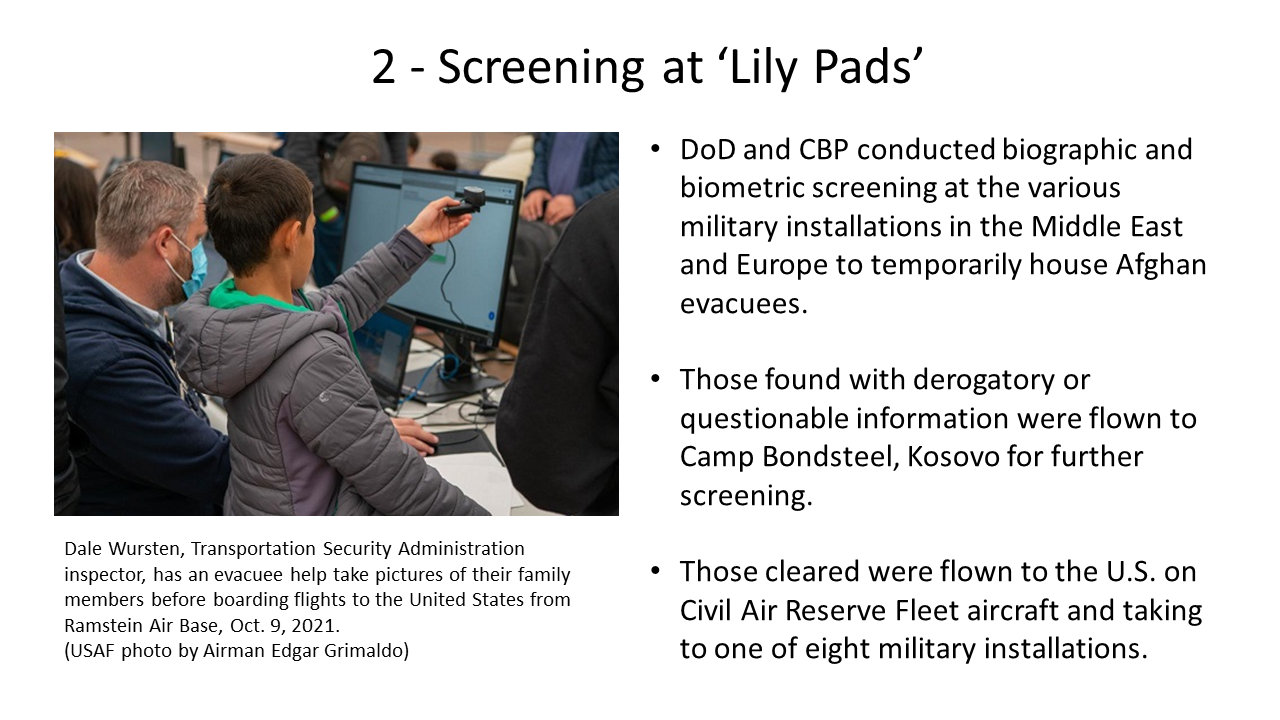
(click here for a larger image)
Screening at Port of Entry by Customs Border Protection (CBP)
Upon entry to the United States through the 'port of entries', the
Afghan evacuees were processed by the Customs and Border Patrol (CBP).
Questionable 'cases' were detained for further questioning. Those with a
criminal past or judged to be a security threat were detained for
further dispostion by the CBP.
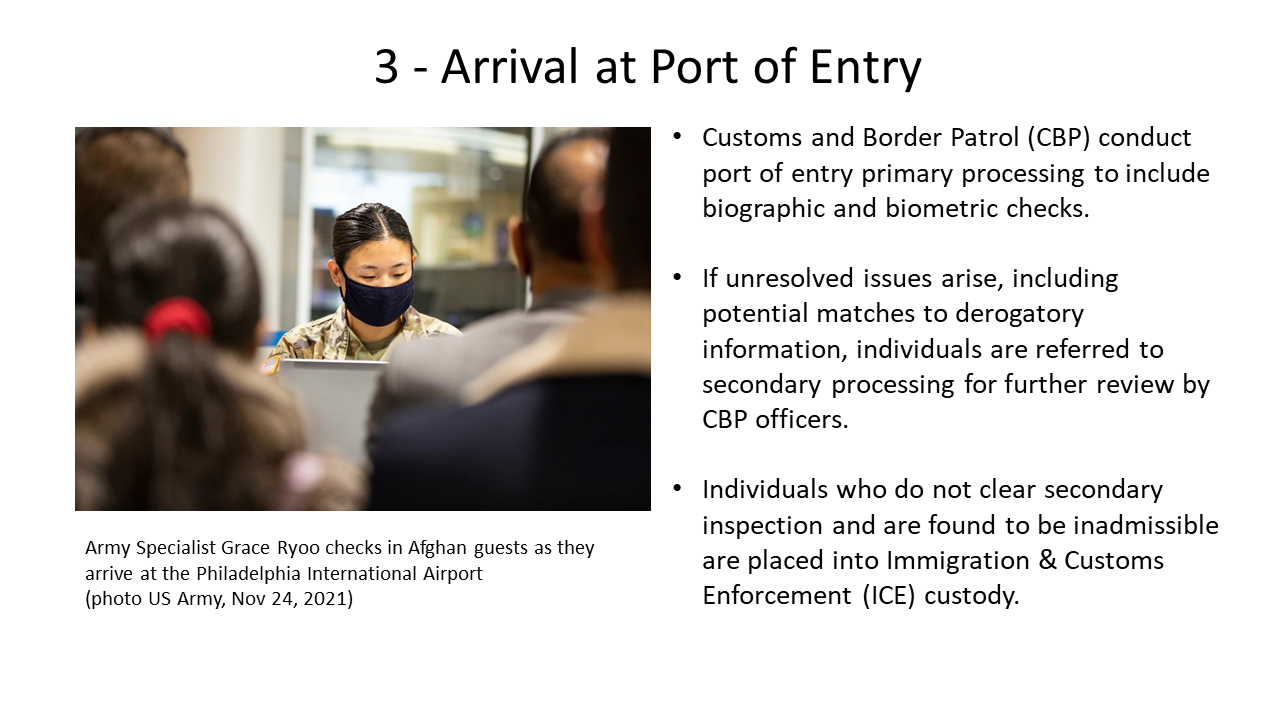
(click here for a larger image)
Screening at During Initial Months in the U.S.
Most of the Afghan evacuees (excepting AMCITS, LPRs, and SIVs with
approved visas) were housed and processed on one of eight military
installations across the country. Most spent from 3 to 6 months on these
military bases prior to being resettled in a U.S. community.
Administrative, medical, dental, and security screening was conducted
during this time.
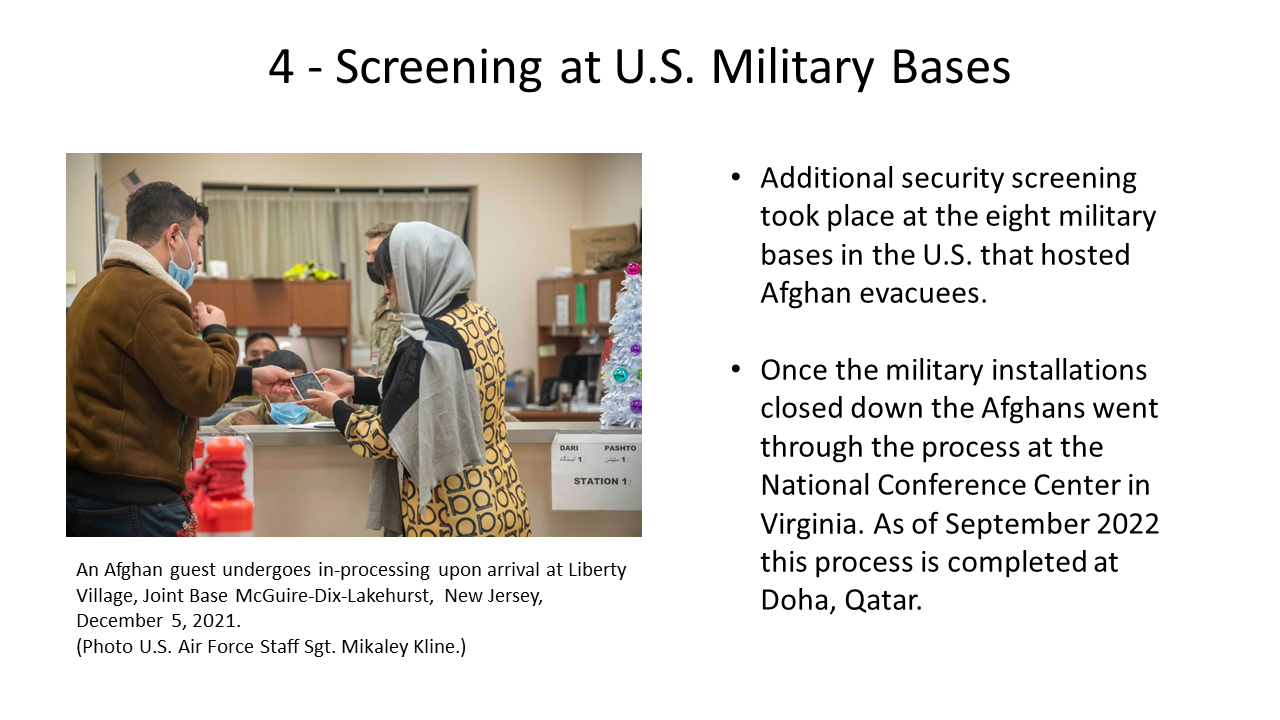
(click here for a larger image)
Vetting of Afghan Evacuees if the
Afghan Adjustment Act Passes Congress
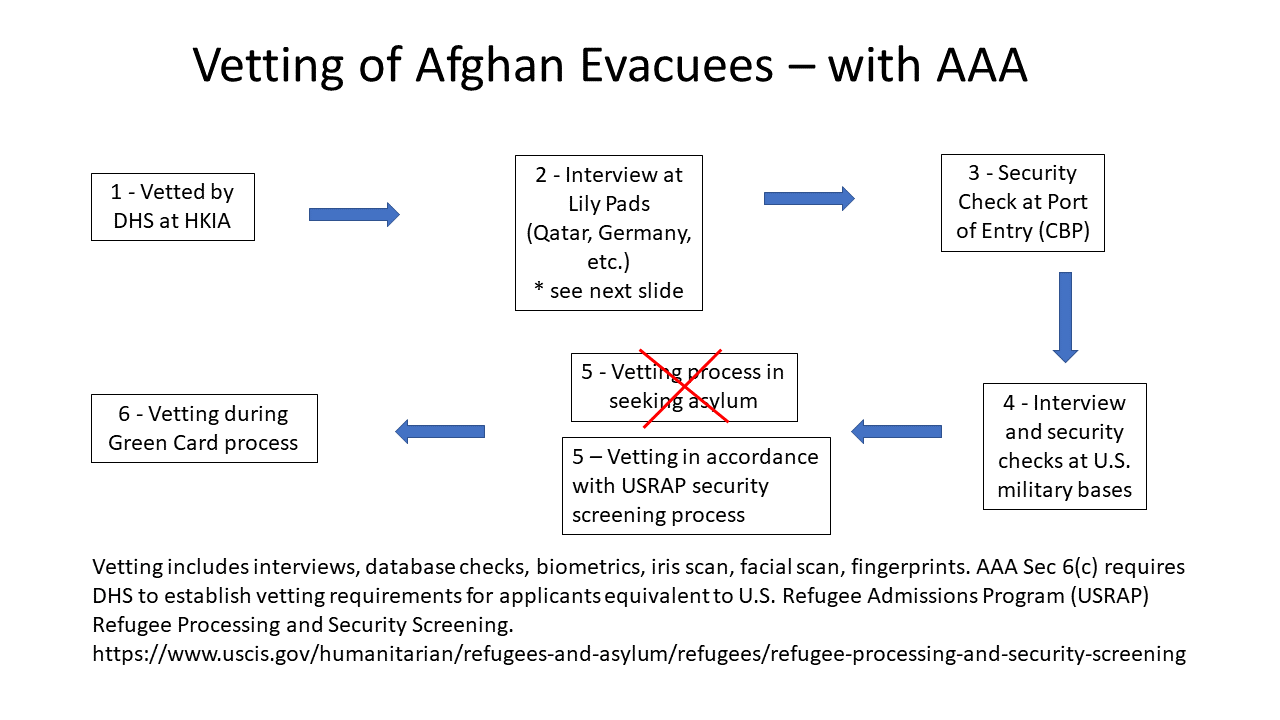
(click
here for a larger image)
Refugee Security Screening Fact Sheet
U.S. Citizenship and Immigration Services (USCIS)
Department of Homeland Security
June 3, 2020, PDF, 7 pages
return to screening description
Vetting Of Former Members of Afghan Security Forces
Prior to August 2021 and Taliban Takeover
Afghans who joined the Afghan Security Forces were screened and
vetted as part of the recruitment process. Almost all of them, at least
after 2010, had their biometrics recorded in a database maintained by
the Ministry of Interior (MoI) or Ministry of Defense (MoD). Some of the
80,000 plus Afghan evacuees now in the United States are former members
of the Afghan National Army (ANA), Afghan National Police (ANP),
National Directorate of Security (NDS), Afghan Air Force (AAF), Special
Mission Wing (SMW), Afghan National Army Special Operations Command
(ANASOC), Female Tactical Platoon (SOF), and Combat interpreters. Each
of these units had their own security process for their respective
units. For instance, the Afghans who served in Afghan special operations
units went through an intensive screening process - described in the
graphic below.
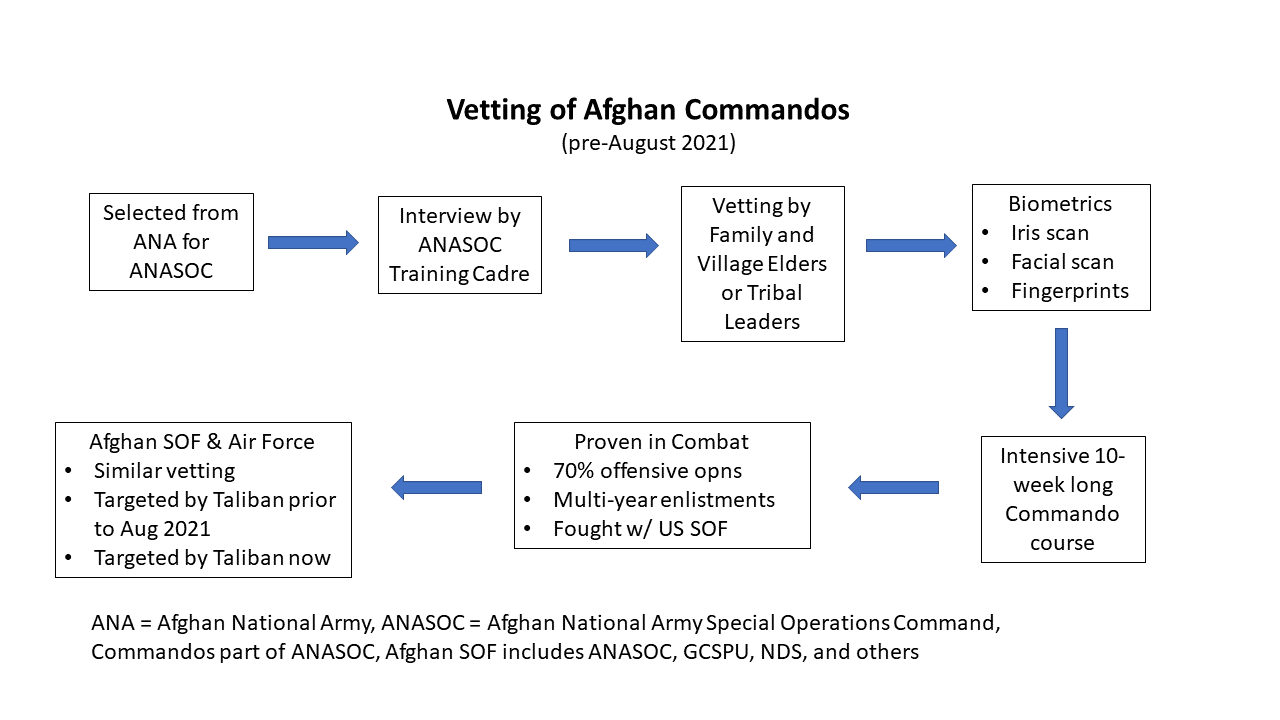
(click
here for a larger image)
Return to Top of Page
|
